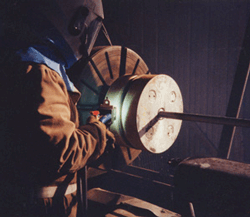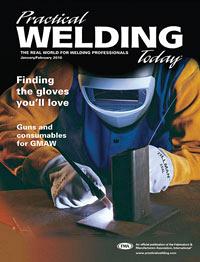Contributing Writer
- FMA
- The Fabricator
- FABTECH
- Canadian Metalworking
Categories
- Additive Manufacturing
- Aluminum Welding
- Arc Welding
- Assembly and Joining
- Automation and Robotics
- Bending and Forming
- Consumables
- Cutting and Weld Prep
- Electric Vehicles
- En Español
- Finishing
- Hydroforming
- Laser Cutting
- Laser Welding
- Machining
- Manufacturing Software
- Materials Handling
- Metals/Materials
- Oxyfuel Cutting
- Plasma Cutting
- Power Tools
- Punching and Other Holemaking
- Roll Forming
- Safety
- Sawing
- Shearing
- Shop Management
- Testing and Measuring
- Tube and Pipe Fabrication
- Tube and Pipe Production
- Waterjet Cutting
Industry Directory
Webcasts
Podcasts
FAB 40
Advertise
Subscribe
Account Login
Search
Thermal spray safety and OSHA compliance
Protecting operators from ultraviolet light, fumes, dust, compressed air, gases
- By Charles P. Howes
- July 12, 2001
- Article
- Safety
Thermal spray equipment normally is operated in special enclosures designed to reduce noise levels, extract fumes, and provide direct viewing of the spray nozzle when it's used in high production environments.
Occasionally R&D projects, large parts, low production runs, or complex part geometry may require manual spray operations. When the operator has to work directly with the part, the engineering controls provided to ensure operator safety often are ignored. Following a few safety rules and being conscious of potential hazards can help ensure operator safety during manual operation of the thermal spray process.
Ultraviolet Light
Although the Occupational Safety and Health Administration (OSHA) standard for nonionizing radiation restricts electromagnetic radiation to only that portion of the spectrum defined as radio frequency, thermal spray systems produce UV light, which is defined as nonionizing radiation. Safety rules applicable to thermal spray can be found in OSHA standard Subpart Q — Welding, Cutting, and Brazing of 29CFR 1910.
Flame spray processes such as combustion produce intense, bright flames that may have a peak temperature in excess of 3,100 C. Two-wire electric arc thermal spray systems produce nonionizing radiation in the electromagnetic spectrum region of 320 to 280 nanometers (nm), also called the UV-B or erythemal region.
Plasma systems with much brighter arc intensity operate between 280 and 220 nm, also called the UV-C region. Plasma systems operating in this range also generate ozone. The cornea of the eye absorbs the UV from these regions easily, leading to a condition called flash burn after prolonged exposure.
The severity of flash burn depends on the duration of exposure, UV wavelengths, and the energy level at which the luminance and radiance are produced during the process. Eyes can be damaged without discomfort during exposure.
UV produced by thermal spray processes can affect exposed skin, causing sunburn, sun tanning, and changes in skin cell growth. Repeated exposure to UV may decrease skin elasticity. This can give the appearance of premature aging and can lead to a higher risk of skin cancer.
It is important to install UV dark glass or shades over the windows of spray booths and enclosures. If this is not possible, operators and others in the area should wear No. 6 green welding goggles. They also should place welding screens around open spray areas and never allow the themselves or others to view the plume of a spray gun without adequate eye protection.
Fumes and Dust
The thermal spray process atomizes molten metals, creating dust and fumes that can be dangerous to the operator. Engineering controls such as dust collectors, ventilation, and air makeup units are necessary to provide good spray coatings and to protect the operator's health and safety.
All finely divided metal particles are potentially ignitable and should not accumulate as dust in the spray environment. Materials such as aluminum, zinc, and other base metals may react with water to produce hydrogen, an explosive gas.
Other sprayed materials also can be hazardous. For example, nickel and chromium are suspected carcinogens. Fumes from bronze, zinc, and copper alloys are unpleasant to smell and may cause a fever-type reaction known as brass chills.
Where engineering controls and good ventilation are not available, a supplied-air, positive-pressure or SCBA respirator may be necessary. If engineering controls and good ventilation are available, a negative-pressure half-mask respirator equipped with OV/P-100 filters should be used as a minimum. OV stands for organic vapor, the P stands for oilproof, and the 100 stands for 99.97 percent efficient against solid or liquid particles, including oil-based particles.
These are HEPA-class filters approved for protection against dust, fumes, and mists that have a time-weighted average of less than 0.05 milligram per cubic meter, or 2 million particles per cubic foot. These filters generally are color-coded magenta and gray with a black National Institute of Occupational Safety and Health (NIOSH) label. Filters whose elements are encased in a plastic or metal container offer more protection against the open flames and sparks generated by thermal spray processes than low-profile filters with cloth or paper exteriors. If low-profile filters are used, a spark shield should be installed over the element.
Compressed Air
Thermal spray equipment generally operates at high air pressures. Some commonsense safety practices for operators include the following:
- Use hoses rated for high pressure.
- Never clean powder off equipment or clean spray cubicles with compressed air.
- Don't use compressed air to clean clothing.
- Don't supply plant compressed air to a breathing apparatus.
- Reduce compressed air to less than 30 pounds per square inch (PSI) for cleaning purposes; use only with effective chip guarding and personal protective equipment (see 29CFR 1910.242).
Gases
Thermal spray processes use many different industrial gases, including acetylene, argon, propylene, helium, hydrogen, kerosene, and oxygen (see Subpart H - - Hazardous Materials of Part 1910 OSHA standards). Gas leakage must be prevented, and oxygen and fuel gas supplies should be isolated when not in use.
Industrial gases are under pressure; an operator should never work on a pressurized system. If the operator finds a leak, he should close the tank valve, blow down the system by venting to a safe place, and then repair the leak. Sparkproof tools and explosionproof equipment should be used, and all equipment grounded and used with adequate ventilation.
It also is important that operators read applicable MSDSs before using gases or materials, and pressurize and leak-check any repairs to a gas line before operating the equipment.
Understanding Thermal Spray Equipment Dangers
Thermal spray equipment is no more or less dangerous than any other industrial equipment. Safe operation is enhanced by thoroughly researching safety issues and establishing and following a set of standard operating procedures and checklists.
For more information on OSHA regulations, contact the U.S. Department of Labor, Occupational Safety and Health Administration, 200 Constitution Avenue, N.W., Washington, DC 20210, Web site www.osha.gov.
For additional information on thermal spray safety, see Charles P. Howes' related article, "Thermal spray safety and OSHA compliance: Protecting operators from noise, electricity," in the September/October 2001 Practical Welding Today
About the Author
About the Publication
subscribe now

The Welder, formerly known as Practical Welding Today, is a showcase of the real people who make the products we use and work with every day. This magazine has served the welding community in North America well for more than 20 years.
start your free subscription- Stay connected from anywhere

Easily access valuable industry resources now with full access to the digital edition of The Fabricator.

Easily access valuable industry resources now with full access to the digital edition of The Welder.

Easily access valuable industry resources now with full access to the digital edition of The Tube and Pipe Journal.
- Podcasting
- Podcast:
- The Fabricator Podcast
- Published:
- 04/16/2024
- Running Time:
- 63:29
In this episode of The Fabricator Podcast, Caleb Chamberlain, co-founder and CEO of OSH Cut, discusses his company’s...
- Trending Articles
Sheffield Forgemasters makes global leap in welding technology

ESAB unveils Texas facility renovation

Engine-driven welding machines include integrated air compressors

The impact of sine and square waves in aluminum AC welding, Part I

How welders can stay safe during grinding

- Industry Events
16th Annual Safety Conference
- April 30 - May 1, 2024
- Elgin,
Pipe and Tube Conference
- May 21 - 22, 2024
- Omaha, NE
World-Class Roll Forming Workshop
- June 5 - 6, 2024
- Louisville, KY
Advanced Laser Application Workshop
- June 25 - 27, 2024
- Novi, MI



























